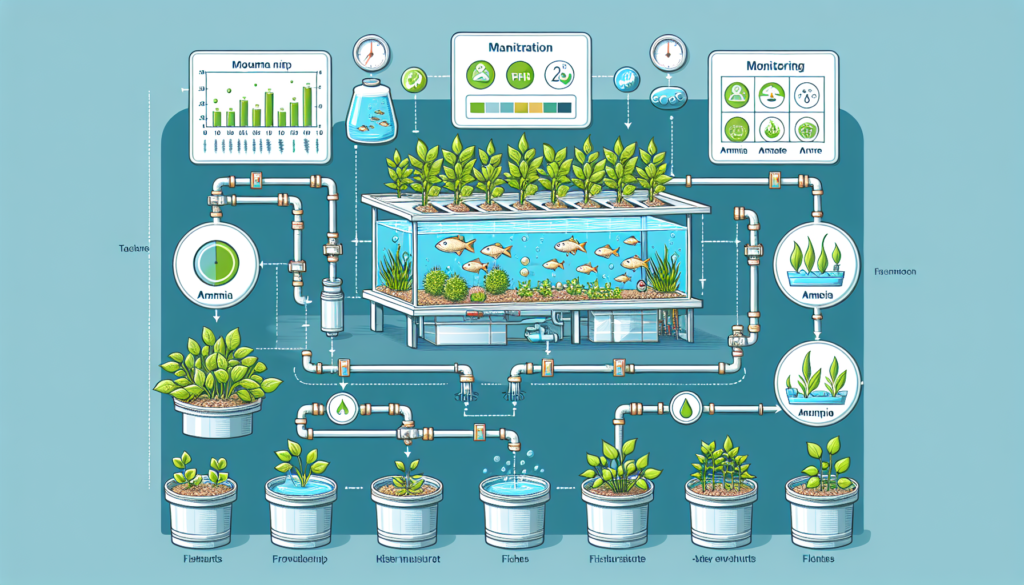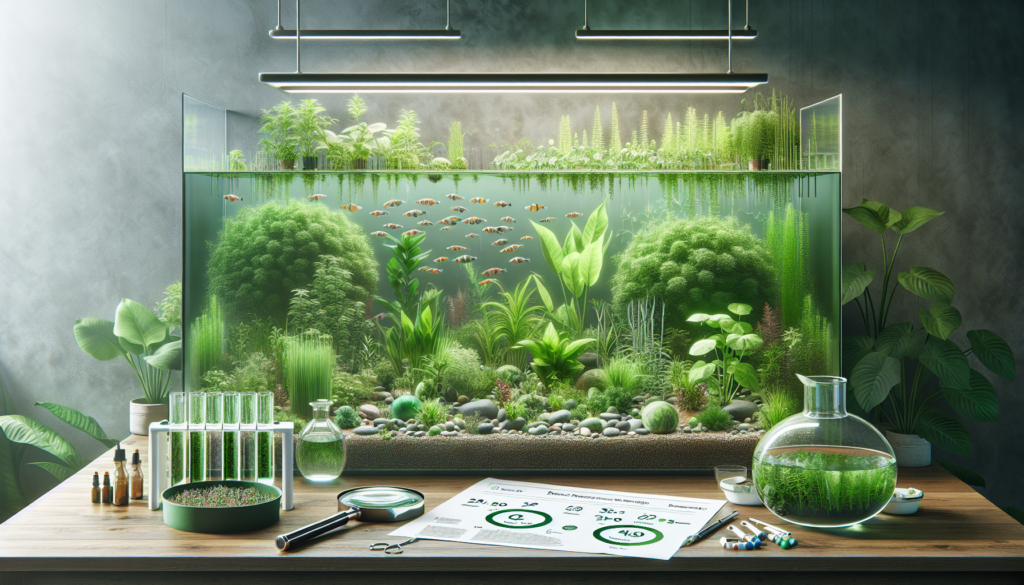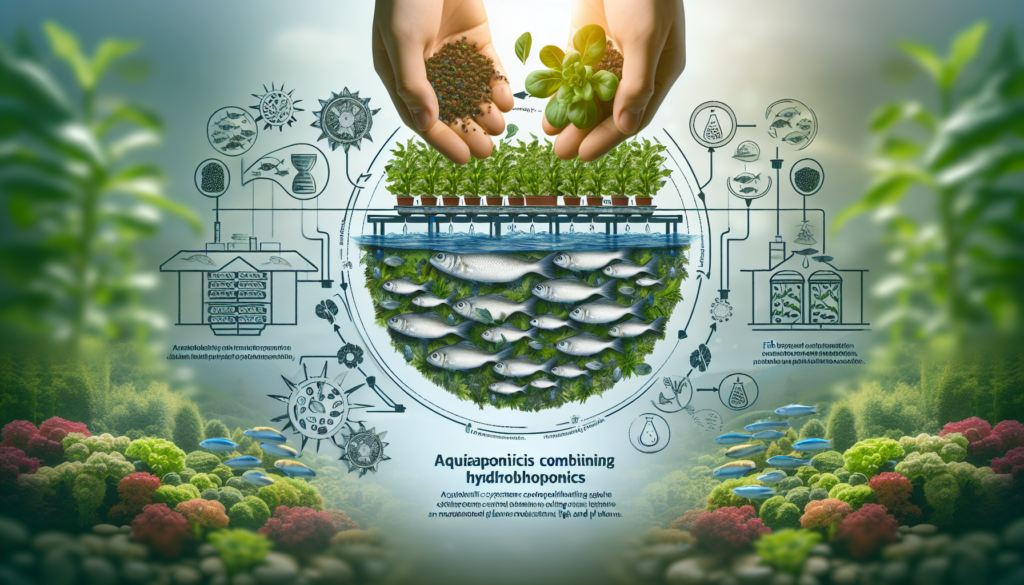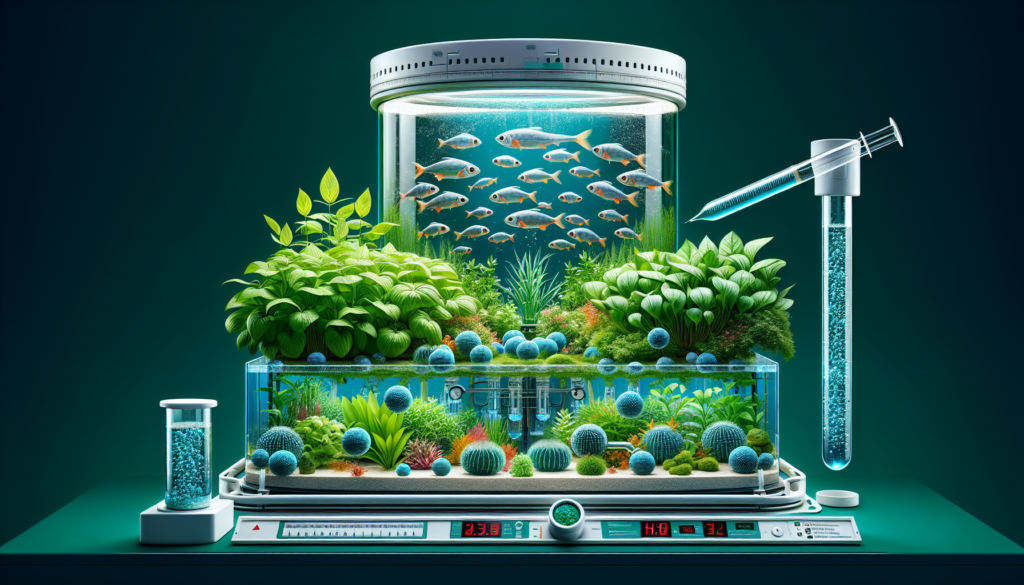Imagine being able to grow your own fresh and healthy produce from the comfort of your own home, all while reducing your environmental impact. With aquaponics, you can start growing plants in aquaponics. This innovative farming technique combines aquaculture and hydroponics to create a self-sustaining system where fish and plants work in harmony. By harnessing the power of nature and the symbiotic relationship between fish and plants, aquaponics offers a solution for maximum plant production and minimal maintenance. Say goodbye to traditional gardening methods and discover a new way to grow plants that is both efficient and rewarding.
Choosing the Right Aquaponics System
Aquaponics systems come in various forms, and choosing the right one is crucial for the success of your aquaponics venture. Understanding the different types of systems available is the first step towards making an informed decision.
Understanding different types of systems
The three main types of aquaponics systems are media-based, deep water culture (DWC), and nutrient film technique (NFT). In a media-based system, plants grow in a medium such as gravel or expanded clay pellets, which provides both support and a surface for beneficial bacteria to colonize. DWC systems involve suspending plant roots directly in the nutrient-rich water. NFT systems utilize a constant, thin film of nutrient-rich water flowing over the plant roots, allowing for optimal nutrient absorption.
Factors to consider when choosing a system
Several factors should be considered when selecting an aquaponics system. The available space, budget, desired plant variety, and personal preferences all play a role in determining which system is the most suitable for you. Additionally, consider the level of expertise you possess and the amount of time and effort you are willing to invest in maintaining the system.
Comparing media-based, deep water culture, and nutrient film technique systems
Media-based systems are often preferred by beginners due to their simplicity and versatility. They are well-suited for a wide range of plants, including larger and fruiting varieties. deep water culture systems are known for their efficiency in nutrient delivery and are commonly used for fast-growing plants like lettuce and herbs. Nutrient film technique systems are ideal for growing lightweight, leafy greens, as they offer excellent aeration and nutrient distribution.
Selecting Suitable Plants for Aquaponics
Choosing the right plants for your aquaponics system is crucial for maximizing production and ensuring a thriving ecosystem. Understanding which plants thrive in aquaponics and considering specific factors will help you make informed plant selection decisions.
Types of plants that thrive in aquaponics
Many plants thrive in aquaponics, including culinary herbs like basil, mint, and parsley, leafy greens such as lettuce and spinach, and fruiting plants like tomatoes and cucumbers. Additionally, you can also grow flowering plants, decorative plants, and even certain root vegetables. The key is to select plants that have similar water, temperature, and nutrient requirements to maintain a balanced and harmonious environment in your aquaponics system.
Considerations for plant selection
Aside from considering the water, temperature, and nutrient requirements, other factors must be taken into account when selecting plants for your aquaponics system. Consider the available space in your system, as some plants may require more room to grow than others. Also, think about the production goals and market demand for specific plants to ensure profitability. Finally, consider your own preferences and the types of plants you enjoy growing and consuming.
Examples of popular plants for aquaponics
Popular plants for aquaponics include lettuce, kale, Swiss chard, basil, mint, and cilantro. These leafy greens and culinary herbs are well-suited to the nutrient-rich environment provided by aquaponics systems. Other popular choices include tomatoes, cucumbers, peppers, and strawberries, which are all fruiting plants that can yield plentiful harvests in aquaponics systems. Don’t be afraid to experiment and try out different plants to find your favorites!

Optimizing Water Quality
Maintaining optimal water quality is crucial in ensuring the health and productivity of your aquaponics system. Understanding the importance of water quality and implementing appropriate measures will help you create an ideal environment for your plants and fish.
Understanding the importance of water quality
Water quality directly affects the growth and development of both plants and fish in your aquaponics system. The water serves as the medium through which vital nutrients are delivered to the plants, and it also provides the habitat in which fish thrive. Monitoring and maintaining water quality parameters such as pH levels, nutrient concentrations, temperature, and dissolved oxygen are essential for the overall success of your system.
Maintaining proper pH levels
The pH level of the water is crucial as it affects nutrient availability for plants and the health of fish. Most plants thrive in a slightly acidic to neutral pH range, typically between 6.0 to 7.0. Regularly monitoring and adjusting the pH levels using pH testing kits and appropriate organic acids or bases is important for maintaining optimal conditions for both plants and fish.
Monitoring and adjusting nutrient levels
Maintaining balanced nutrient levels is essential for healthy plant growth. Regularly monitoring and adjusting nutrient levels, including nitrogen, phosphorus, potassium, and micronutrients, will ensure that plants have access to the necessary elements for growth and development. Using water testing kits and appropriate organic nutrient supplements or additives can help achieve and maintain optimal nutrient concentrations.
Controlling temperature and dissolved oxygen
Both temperature and dissolved oxygen levels play critical roles in the health and productivity of your aquaponics system. Most plants and fish thrive within specific temperature ranges, so monitoring and controlling water temperature is important to prevent stress or overheating. Additionally, maintaining adequate dissolved oxygen levels through proper aeration and water circulation promotes healthy root development and optimal fish behavior.
Providing Adequate Lighting
Proper lighting is essential for the growth and productivity of plants in your aquaponics system. Understanding the lighting requirements of different plant species and selecting the right type of lighting will help maximize photosynthesis and ensure healthy plant growth.
Determining the lighting requirements
Different plants have varying lighting requirements, including the intensity and duration of light exposure. Research the specific light requirements of the plants you intend to grow in your aquaponics system to provide them with adequate lighting. Pay attention to factors such as the amount of sunlight available, as some plants may require full sun exposure, while others prefer partial shade.
Different types of lighting for aquaponics
There are several types of lighting commonly used in aquaponics, including sunlight, fluorescent lights, and LED lights. Utilizing natural sunlight is an ideal and cost-effective option, but it’s crucial to position your system in an area that receives sufficient sunlight throughout the day. Fluorescent lights are commonly used for indoor aquaponics systems, as they are energy-efficient and provide a full spectrum of light. LED lights offer similar benefits and can be customized to provide specific wavelengths of light, optimizing plant growth.
Managing light intensity and duration
Proper light intensity and duration are crucial for photosynthesis and plant growth. Ensure that your plants receive the appropriate intensity of light by positioning your lighting source at an optimal distance from the plant canopy. Adjusting the duration of light exposure, typically between 12-18 hours per day, will mimic natural day and night cycles and promote healthy growth. Consider using timers or automated systems to ensure consistent and adequate lighting for your plants.

Managing Nutrient Levels
Balancing nutrient levels in your aquaponics system is essential for maintaining healthy plant growth and maximizing productivity. Understanding the role of nutrients, balancing macronutrients and micronutrients, using organic supplements, and preventing nutrient deficiencies and excesses are key in managing nutrient levels effectively.
Understanding the role of nutrients in aquaponics
Nutrients provide essential elements for plant growth and development in an aquaponics system. Macronutrients, such as nitrogen, phosphorus, and potassium, are required in larger quantities, while micronutrients, including iron, manganese, and zinc, are needed in smaller amounts. Maintaining optimal nutrient levels ensures that plants have access to the necessary elements for photosynthesis, root development, and overall health.
Balancing macronutrients and micronutrients
Keeping a balanced ratio of macronutrients and micronutrients is crucial for avoiding deficiencies or excesses that can hinder plant growth. Monitoring nutrient levels regularly using water testing kits and adjusting nutrient inputs accordingly will help maintain a healthy nutrient balance. Organic supplements and additives can also be used to provide specific nutrients that may be lacking to promote optimal plant growth.
Using organic supplements and additives
Organic supplements and additives can be beneficial in enhancing nutrient availability and promoting overall plant health. For example, fish emulsion or seaweed extract can provide additional nitrogen and trace minerals. Compost teas are rich in beneficial microbes that help break down organic matter and make nutrients more accessible to plants. Utilizing these organic supplements and additives can supplement the existing nutrient cycle in your aquaponics system and boost plant growth.
Preventing nutrient deficiencies and excesses
Regular monitoring of nutrient levels is crucial in identifying and addressing any potential nutrient deficiencies or excesses. Signs of nutrient deficiencies may include yellowing or stunted growth, while excessive nutrient levels can cause nutrient burn or toxicity symptoms in plants. Adjusting nutrient inputs and ensuring a balanced nutrient solution will help prevent these issues and promote optimal plant health.
Controlling Pest and Disease
Preventing and managing pests and diseases is crucial for ensuring the health and productivity of your aquaponics system. Identifying common pests and diseases, implementing preventive measures, using natural pest control methods, and addressing disease outbreaks promptly are key in controlling pest and disease issues.
Identifying common pests and diseases
Common pests in aquaponics systems include aphids, whiteflies, thrips, and spider mites. These pests can cause damage to plant leaves, spread diseases, and reduce overall plant productivity. Diseases such as fungal infections, bacterial infections, and viral diseases can also affect plant health and yield. Regularly inspecting plants for signs of pests or diseases and promptly identifying them is essential for effective control.
Implementing preventive measures
Prevention is the first line of defense against pests and diseases. Implementing measures such as practicing good hygiene, regularly cleaning and maintaining the aquaponics system, and quarantining new plants before introducing them into the system can help prevent the introduction and spread of pests and diseases. Additionally, providing optimal growing conditions, such as maintaining proper nutrient levels, adequate lighting, and proper environmental conditions, will strengthen plants and make them more resistant to pests and diseases.
Using natural pest control methods
Utilizing natural pest control methods is a safe and environmentally friendly approach to managing pests in your aquaponics system. Examples include introducing beneficial insects like ladybugs or predatory mites that prey on pests, using organic pest control sprays derived from neem or garlic, and implementing physical barriers such as insect netting to prevent pest entry. These methods target pests directly while minimizing the use of harmful chemicals.
Addressing disease outbreaks
If disease outbreaks occur in your aquaponics system, prompt action is vital to prevent further spread and minimize damage. Isolate affected plants as soon as possible to prevent disease transmission to healthy plants. Evaluate the potential causes of the outbreak, such as water quality issues or nutrient imbalances, and take appropriate corrective measures. Consult with experts or local agricultural extension offices if necessary to identify the specific disease and implement the most effective treatment strategies.

Ensuring Proper Plant Spacing
Proper plant spacing is essential for optimizing growth and productivity in your aquaponics system. Determining ideal plant spacing, considering plant size and growth characteristics, and preventing overcrowding and competition will promote healthy development and maximize yield.
Determining ideal plant spacing
The ideal plant spacing in your aquaponics system depends on the growth habit and size of the plants you are cultivating. Research the recommended spacing guidelines for each plant species to ensure optimal airflow, light penetration, and access to nutrients and water. Adequate spacing provides space for each plant to grow without excessive competition and allows for efficient maintenance and harvesting.
Considering plant size and growth characteristics
Take into account the expected size and growth characteristics of the plants you intend to grow in your aquaponics system. Some plants, such as leafy greens, have a compact growth habit and can be grown in close proximity to each other. On the other hand, fruiting plants such as tomatoes or cucumbers require more space and support structures for the weight of their fruits. Understanding the unique needs of each plant will help you determine the appropriate spacing requirements.
Preventing overcrowding and competition
Overcrowding and competition for resources can hinder plant development and productivity. When plants are too close together, they compete for light, nutrients, and water, resulting in stunted growth and reduced yields. Maintaining proper plant spacing ensures that each plant has sufficient access to resources and promotes optimal growth. Regularly monitor the growth of your plants and make necessary adjustments to spacing as they mature.
Maintaining an Optimal Growing Environment
Creating and maintaining an optimal growing environment is key to the success of your aquaponics system. Controlling humidity and ventilation, managing air circulation, avoiding temperature fluctuations, and monitoring and adjusting CO2 levels are all essential aspects of maintaining an ideal environment for plant growth.
Controlling humidity and ventilation
Proper humidity levels are crucial for plant health and preventing the growth of mold and diseases. The optimal humidity range for most plants in aquaponics is between 50% and 70%. Good ventilation is essential in controlling humidity levels, preventing stagnation, and ensuring the circulation of fresh air. Consider using fans or natural ventilation methods to maintain an optimal growing environment.
Managing air circulation
Air circulation is important for preventing stagnant air pockets, dispersing excess heat, and ensuring optimal gas exchange. Proper air circulation helps prevent the buildup of humidity and reduces the risk of fungal diseases. Positioning fans strategically to promote airflow and avoiding overcrowding of plants will help maintain optimal air circulation within your aquaponics system.
Avoiding temperature fluctuations
Plants in aquaponics systems thrive within specific temperature ranges, and avoiding temperature fluctuations is critical for their growth and productivity. Fluctuating temperatures can stress plants and lead to reduced yields. Maintaining a consistent temperature within the recommended range for your plant species is crucial. Consider implementing measures such as insulation, shade cloths, or greenhouse covers to regulate temperature and protect plants from extreme heat or cold.
Monitoring and adjusting CO2 levels
Carbon dioxide (CO2) is essential for photosynthesis and optimal plant growth. Monitoring and maintaining adequate CO2 levels within your aquaponics system is crucial for maximizing plant productivity. Maintaining proper air circulation and avoiding overcrowding can help ensure sufficient CO2 exchange. If necessary, supplemental CO2 can be added using CO2 generators or by introducing CO2-rich air from other sources to maintain an optimal CO2 concentration.

Harvesting and Pruning Techniques
Knowing when to harvest different plant types and implementing proper pruning and trimming techniques are important aspects of maximizing production in your aquaponics system. Understanding proper timing, techniques, and promoting continuous growth will help optimize yield and ensure long-term success.
Knowing when to harvest different plant types
Each plant has specific maturity indicators that determine the optimal time for harvest. Leafy greens are typically harvested when they reach a certain size, whereas fruiting plants are harvested once the fruits have reached their desired stage of ripeness. Regularly monitor your plants and observe the recommended harvest times for each specific plant variety to ensure the highest quality of produce.
Proper techniques for pruning and trimming
Pruning and trimming are techniques used to maintain plant health, control growth, and promote continuous harvests. Removing dead or damaged leaves, trimming back excessive growth, and shaping plants can help maintain overall plant health and appearance. Additionally, pruning can stimulate lateral branching and encourage the development of more flowers or fruits, resulting in increased productivity.
Promoting continuous growth and productivity
To promote continuous growth and productivity, it is beneficial to implement techniques such as staggered planting or succession planting. Staggered planting involves planting new seedlings or transplants at regular intervals, ensuring a continuous supply of fresh produce. Succession planting involves planting new crops as soon as the previous batch is harvested. These techniques maximize the use of space and resources, ensuring a steady harvest throughout the year.
Record Keeping and Data Analysis
Maintaining accurate records and analyzing data is essential for the long-term success and improvement of your aquaponics system. Tracking plant growth and yield, analyzing data for future improvements, and utilizing technology for data management will help you make informed decisions and optimize your system.
Importance of maintaining records
Keeping detailed records of your aquaponics system’s performance is crucial for understanding its strengths and weaknesses. By tracking important parameters such as water quality, nutrient levels, plant growth rates, and harvest yields, you can identify patterns and trends over time. This information will guide your decision-making process and allow you to make informed adjustments and improvements.
Tracking plant growth and yield
Regularly monitoring and recording plant growth and yield is important for evaluating the productivity of your aquaponics system. Documenting growth rates, final plant sizes, and total harvest yields will help you assess the performance of different plant species, varieties, or growing techniques. It will also provide valuable data for future crop planning and optimization.
Analyzing data for future improvements
Analyzing recorded data allows you to identify areas for improvement in your aquaponics system. By analyzing trends and patterns, you can make informed decisions regarding adjustments to nutrient levels, lighting, or other environmental factors. Studying past performance and comparing it to desired outcomes will help guide your decision-making process and foster continuous improvement.
Utilizing technology for data management
Technology can greatly simplify the task of record-keeping and data analysis in aquaponics systems. Utilize tools such as spreadsheets, digital timers, and monitoring systems to streamline data collection and analysis. Automation and remote monitoring systems can provide real-time data on water quality, temperature, and other crucial parameters, allowing for more efficient management and timely decision-making.
In conclusion, successful aquaponics gardening requires careful consideration and attention to various factors. By choosing the right aquaponics system, selecting suitable plants, optimizing water quality, providing adequate lighting, managing nutrient levels, controlling pests and disease, ensuring proper plant spacing, maintaining an optimal growing environment, implementing proper harvesting and pruning techniques, and utilizing record-keeping and data analysis, you can maximize production and enjoy a thriving aquaponics ecosystem. With the right knowledge, dedication, and passion, you can embark on a rewarding journey of sustainable and bountiful aquaponics gardening.
